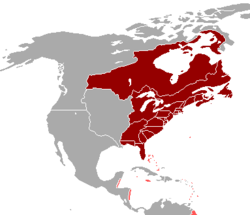British America
English America, and later British America, were the English, and later British, territories in North America (including Bermuda), Central America, the Caribbean, and Guyana from 1607 to 1783. Formally, the British colonies in North America were known as British America and the British West Indies until 1776, when the Thirteen British Colonies located along the Atlantic seaboard declared their independence and formed the United States of America. After that, British North America (or, simply but not inclusively, Canada) was used to describe the remainder of Britain's continental North American possessions. The term "British North America" was first used informally in 1783, but it was uncommon before the Report on the Affairs of British North America (1839), called the Durham Report.
British America gained large amounts of new territory following the Treaty of Paris (1763) which ended Britain's involvement in the Seven Years' War. At the start of the American War of Independence in 1775, the British Empire included 20 colonies north and east of New Spain (present-day areas of Mexico and the Western United States). East and West Florida were ceded to Spain in the Treaty of Paris (1783) which ended the American Revolution, and then ceded by Spain to the United States in 1819. All but one of the remaining colonies of British North America apart from the British West Indies united together from 1867 to 1873 forming the Dominion of Canada. Newfoundland joined Canada in 1949.
...
Wikipedia


